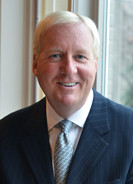Jeffrey D. Byrne
President + CEO
The Giving Institute recently hosted its Summer Symposium in Boston, and I attended a very informative session on “The Charitable Landscape and Donor-Advised Funds” presented by Matt Nash, a Senior Vice President with Fidelity Charitable. I felt the presentation made a good case for donor-advised funds, and has helped me re-shape my thinking around this giving vehicle.
As fundraisers and nonprofit managers, we know donor-advised funds (DAFs) have been a part of American philanthropy for decades. We’ve also undoubtedly noticed (perhaps with some chagrin?) that DAFs are quickly becoming more and more popular vehicles for charitable giving. Their role in shaping the charitable landscape has grown dramatically over the past two decades and we can only expect this trend to continue. Many of us have probably also wondered how to “crack the DAF nut” – how to successfully secure this type of funding and connect with the seemingly anonymous individuals behind the mechanism. Since 1991, Fidelity Charitable has operated as an independent public charity and currently sponsors the nation’s largest DAF program. Its mission includes programming to make giving simple and effective. So how do they do that through a funding mechanism that feels like an enigma, and what are the benefits – to both donors and nonprofits?
I learned a lot about the state of DAFs from Matt’s presentation. For example, Fidelity Charitable holds nearly $15 billion in assets in more than 72,000 DAFs (Fidelity Charitable calls them Giving Accounts) which are held by more than 119,000 individuals (known as donors). The average age when opening a DAF is 54 and the current donor age is 62. Donors establish Giving Accounts as they approach retirement age, and 62% of Fidelity donors say they are using these donor-advised funds as a way to sustain giving through retirement. It is also interesting to note that more than half of Fidelity’s donor contributions were non-cash assets and 3/4 of donors say the ability to donate such assets is a reason for setting up their fund. In 2014, more than half of contributions were made with non-cash assets.
Fidelity Charitable is the second-largest grant making entity in the United States, after the Bill & Melinda Gates Foundation. In 2014, it awarded $2.6 billion in donor-recommended grants to 97,000 charities. The total amount granted by Fidelity has tripled over the past 10 years, as has the number of grants of $1 million or more. In the first six months of the 2015 calendar year alone, Fidelity has set a record with its 310,000 donor-recommended grants.
Once assets have been contributed to a Giving Account, they can be invested for short- or long-term giving goals. Donors can recommend an investment strategy that aligns with their own charitable goals and time frames, and potentially grow their charitable dollars tax free. And most DAF participants list tax benefit as a motivation for using a DAF. Is this “parking” funds? Perhaps. But isn’t it also empowering philanthropy? Absolutely! There is a correlation between investment growth and grant making. Fidelity reported its assets rose from $12.8 billion to $14.9 billion in fiscal year 2014. Grants rose 32% over the previous year. While the average grant size remains consistent, the number of grants per Giving Account continues to grow. And most contributions to Fidelity Charitable are granted out to charities within 10 years.
The median Giving Account balance is just over $16,000, and 60% of Giving Accounts have balances under $25,000. But more than 5,500 accounts have balances upwards of $250,000. The majority of grants were recommended online and Fidelity offers a free, online tool (the DAF Direct Widget) that nonprofits can add to their websites, helping donors recommend grants directly from the charity’s website. Donors are also taking advantage of being able to pre-schedule their giving, and pre-scheduled grants make up about 1/5 of outgoing grants from Fidelity. And contrary to some perceptions, most grants–92% of them–are not anonymous, but include names and addresses for acknowledging the gift.
Consider these takeaways when navigating the world of DAFs and meaningfully engaging DAF (and ultimately your organization’s) donors:
- Flag the DAF and gifts in your donor database
- Recognize the donor in stewardship, not the DAF sponsor
- Seek to engage the donor, even if the initial gift is small
- Be sure to include DAFs in your organization’s “Ways of Giving”
And remember, most donors complement their DAF giving with cash giving; often times, the DAFs are used in strategic and larger giving, while cash or cash equivalent gifts are used for smaller donations and more casual giving. DAFs are becoming increasingly more popular and nonprofits should recognize and work with DAFs and their donors as ways to strengthen philanthropy.



